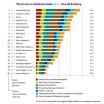(Press-News.org) Changes in how genes in the immune system function may result in age-related macular degeneration (AMD), the leading cause of visual impairment in older adults, based on preliminary research conducted by National Institutes of Health (NIH) investigators.
"Our findings are epigenetic in nature, meaning that the underlying DNA is normal but gene expression has been modified, likely by environmental factors, in an adverse way," said Dr. Robert Nussenblatt, chief of the National Eye Institute (NEI) Laboratory of Immunology. Environmental factors associated with AMD include smoking, diet, and aging. "This is the first epigenetic study revealing the molecular mechanisms for any eye disease."
The study identified decreased levels of DNA methylation, a chemical reaction that switches off genes, on the interleukin-17 receptor C gene (IL17RC). The lack of DNA methylation led to increased gene activity and, in turn, increased levels of IL17RC proteins in patients with AMD. IL17RC is a protein that promotes immune responses to infections, such as fungal attacks.
The study, conducted by research teams from the NEI and other NIH institutes, including the National Heart, Lung, and Blood Institute and the National Center for Complementary and Alternative Medicine; the University of Melbourne, Australia; and Oregon Health and Science University, appears in the Nov. 29 issue of Cell Reports.
"Our study also suggests IL17- and IL17RC-mediated immune responses can be crucial in causing AMD," added Dr. Lai Wei, also of NEI's Laboratory of Immunology and first author on the paper. "By measuring IL17RC gene activity in at-risk patients, we have also potentially identified an early method to detect AMD."
AMD damages the light-sensitive cells of the macula, the central part of the retina that allows us to see fine visual detail. As the disease progresses, patients encounter great difficulty reading, driving, or performing hobbies and tasks that require hand-eye coordination. Treatments exist to prevent severe vision loss in certain types of advanced AMD but none prevent or cure the disease. Currently, 2 million Americans have advanced AMD and another 7 million have intermediate stages.
Recent studies have identified several genes with alterations that increase the risk of developing the disease. In addition, environmental risk factors have also been suggested as possible causes of the disease. One explanation may be that environmental exposures influence DNA methylation, which regulates gene expression. Changes in this process may result in the production of too much or too little of a gene's protein, leading to cellular dysfunction and disease. Changes in DNA methylation have been implicated in cancer, lupus, multiple sclerosis, and many other diseases.
To test whether changes in DNA methylation might play a role in AMD, the investigators evaluated three pairs of twins—one pair identical and two pairs fraternal—where only one of the siblings had AMD. Identical twins have the same genetic makeup while fraternal twins share about half of their DNA. Because of their similar genetic backgrounds, identical and fraternal twins can be helpful in studying the differences between the effects of genetics and the environment. When compared with the unaffected twins, methylation patterns were altered in 231 genes of affected twins. This finding is consistent with the hypothesis that environmental exposures may epigenetically regulate expression of many genes and lead to AMD.
Among the 231 genes, the investigators found that DNA methylation was absent in a region of the IL17RC gene in twins with AMD. The lack of methylation in the IL17RC gene led to increased gene activity and, in turn, increased levels of its protein in circulating blood. The investigators further validated these findings by comparing seven siblings with and without AMD as well as 202 AMD patients and 96 control subjects without the disease. These studies also found increased IL17RC levels in circulating blood and, most importantly, in the retina of patients with AMD but not controls.
Based on these results, the authors propose that chronic increased levels of the IL17RC protein in the retina likely promote inflammation and recruitment of immune cells that damage the retina and lead to AMD.
"This study strongly implicates epigenetic DNA methylation as another crucial biological pathway for understanding the molecular basis of AMD," according to Nussenblatt.
The investigators next plan to evaluate what environmental factors may be responsible for the regulation of IL17RC and how the epigenetic regulation leading to the chronic inflammation in AMD patients can be reversed by novel therapies. They will also evaluate the role of epigenetics in other eye diseases.
###
The National Eye Institute, part of the National Institutes of Health, leads the federal government's research on the visual system and eye diseases. NEI supports basic and clinical science programs that result in the development of sight-saving treatments. For more information, visit http://www.nei.nih.gov.
About the National Institutes of Health (NIH): NIH, the nation's medical research agency, includes 27 Institutes and Centers and is a component of the U.S. Department of Health and Human Services. NIH is the primary federal agency conducting and supporting basic, clinical, and translational medical research, and is investigating the causes, treatments, and cures for both common and rare diseases. For more information about NIH and its programs, visit http://www.nih.gov.
NIH...Turning Discovery Into Health®
NIH study suggests immune system could play a central role in AMD
2012-11-28
ELSE PRESS RELEASES FROM THIS DATE:
Research from ASCO'S Quality Care Symposium shows advances and challenges in improving the quality of cancer care
2012-11-28
ALEXANDRIA, Va. – New studies released today reveal important advances in cancer care quality measurement, physician adherence to quality standards, and end-of-life care, while highlighting the overuse of contralateral prophylactic mastectomy. The studies were released in a presscast today in advance of ASCO's inaugural 2012 Quality Care Symposium. The Symposium will take place November 30 – December 1, 2012, at the Manchester Grand Hyatt in San Diego.
Four major studies were highlighted in today's presscast:
Study finds that most preventive double mastectomies occur ...
Fish ear bones point to climate impacts
2012-11-28
Scientists believe that fish ear bones and their distinctive growth rings can offer clues to the likely impacts of climate change in aquatic environments.
The earbones, or 'otoliths', help fish to detect movement and to orient themselves in the water. Otoliths set down annual growth rings that can be measured and counted to estimate the age and growth rates of fish.
"Otoliths can form the basis of new techniques for modelling fish growth, productivity and distribution in future environments," said Dr John Morrongiello of CSIRO's Wealth from Oceans Flagship, lead author ...
4 is the 'magic' number
2012-11-28
According to psychological lore, when it comes to items of information the mind can cope with before confusion sets in, the "magic" number is seven.
But a new analysis by a leading Australian professor of psychiatry challenges this long-held view, suggesting the number might actually be four.
In 1956, American psychologist George Miller published a paper in the influential journal Psychological Review arguing the mind could cope with a maximum of only seven chunks of information.
The paper, "The Magical Number Seven, Plus or Minus Two. Some Limits on Our Capacity ...
Biggest black hole blast discovered
2012-11-28
Quasars are the intensely luminous centres of distant galaxies that are powered by huge black holes. This new study has looked at one of these energetic objects – known as SDSS J1106+1939 – in great detail, using the X-shooter instrument on ESO's VLT at the Paranal Observatory in Chile [1]. Although black holes are noted for pulling material in, most quasars also accelerate some of the material around them and eject it at high speed.
"We have discovered the most energetic quasar outflow known to date. The rate that energy is carried away by this huge mass of material ...
Potentially toxic flame retardants found in many US couches
2012-11-28
DURHAM, N.C. -- More than half of all couches tested in a Duke University-led study contained potentially toxic or untested chemical flame retardants that may pose risks to human health.
Among the chemicals detected was "Tris," a chlorinated flame retardant that is considered a probable human carcinogen based on animal studies.
"Tris was phased out from use in baby pajamas back in 1977 because of its health risks, but it still showed up in 41 percent of the couch foam samples we tested," said Heather Stapleton, associate professor of environmental chemistry at ...
80 percent of parents interested in genetic risk assessment for siblings of children with autism
2012-11-28
Cambridge, MA (November 28, 2012)--The vast majority (80 percent) of parents with at least one child with Autism Spectrum Disorder (ASD) would pursue genetic testing if a test were available that could identify risk in a younger sibling, citing the desire for earlier identification of children at risk, earlier evaluation and intervention, closer monitoring and lessened anxiety. The findings were reported in "Parental Interest in a Genetic Risk Assessment Test for Autism Spectrum Disorders," a survey published online today in the journal Clinical Pediatrics.
The survey ...
WSU researchers use 3-D printer to make parts from moon rock
2012-11-28
PULLMAN, Wash. - Imagine landing on the moon or Mars, putting rocks through a 3-D printer and making something useful – like a needed wrench or replacement part.
"It sounds like science fiction, but now it's really possible," says Amit Bandyopadhyay, professor in the School of Mechanical and Materials Engineering at Washington State University.
Bandyopadhyay and a group of colleagues recently published a paper in Rapid Prototyping Journal demonstrating how to print parts using materials from the moon.
Bandyopadhyay and Susmita Bose, professor in the School of Mechanical ...
Treating cocaine dependence: A promising new pharmacotherapy
2012-11-28
Philadelphia, PA, November 28, 2012 – Medication development efforts for cocaine dependence have yet to result in an FDA approved treatment. The powerful rewarding effects of cocaine, the profound disruptive impact of cocaine dependence on one's lifestyle, and the tendency of cocaine to attract people who make poor life choices and then exacerbate impulsive behavior all make cocaine a vexing clinical condition.
In this battle, many candidate pharmacotherapies have been tested, but none have succeeded sufficiently to be adopted widely. Perhaps like cancer, heart disease, ...
Brain cell transplants in early 2013
2012-11-28
As part of the European study TRANSEURO, five patients with Parkinson's disease will undergo brain cell transplants at Skåne University Hospital in Lund, Sweden, in early 2013. These are the first operations of their kind in Europe for over 10 years.
The TRANSEURO study, which in Sweden is led by Lund University, is now taking a critical approach to the viability of cell therapy as a future treatment for Parkinson's disease. Can we replace cells that die as a result of our most common neurological diseases? What are the therapies of the future for neurodegenerative diseases ...
Report finds Big Pharma is doing more for access to medicine in developing countries
2012-11-28
Amsterdam, the Netherlands: The latest Access to Medicine Index, which ranks the top 20 pharmaceutical companies on their efforts to improve access to medicine in developing countries, finds that the industry is doing more than it was two years ago, with GlaxoSmithKline still outperforming its peers, but an expanding group of leaders closing the gap.
The Index, published Wednesday, found that Johnson & Johnson was one of the most dramatic risers, climbing from the middle of the field in 9th position in the 2010 Index to 2nd this year, closely behind GlaxoSmithKline. It ...



